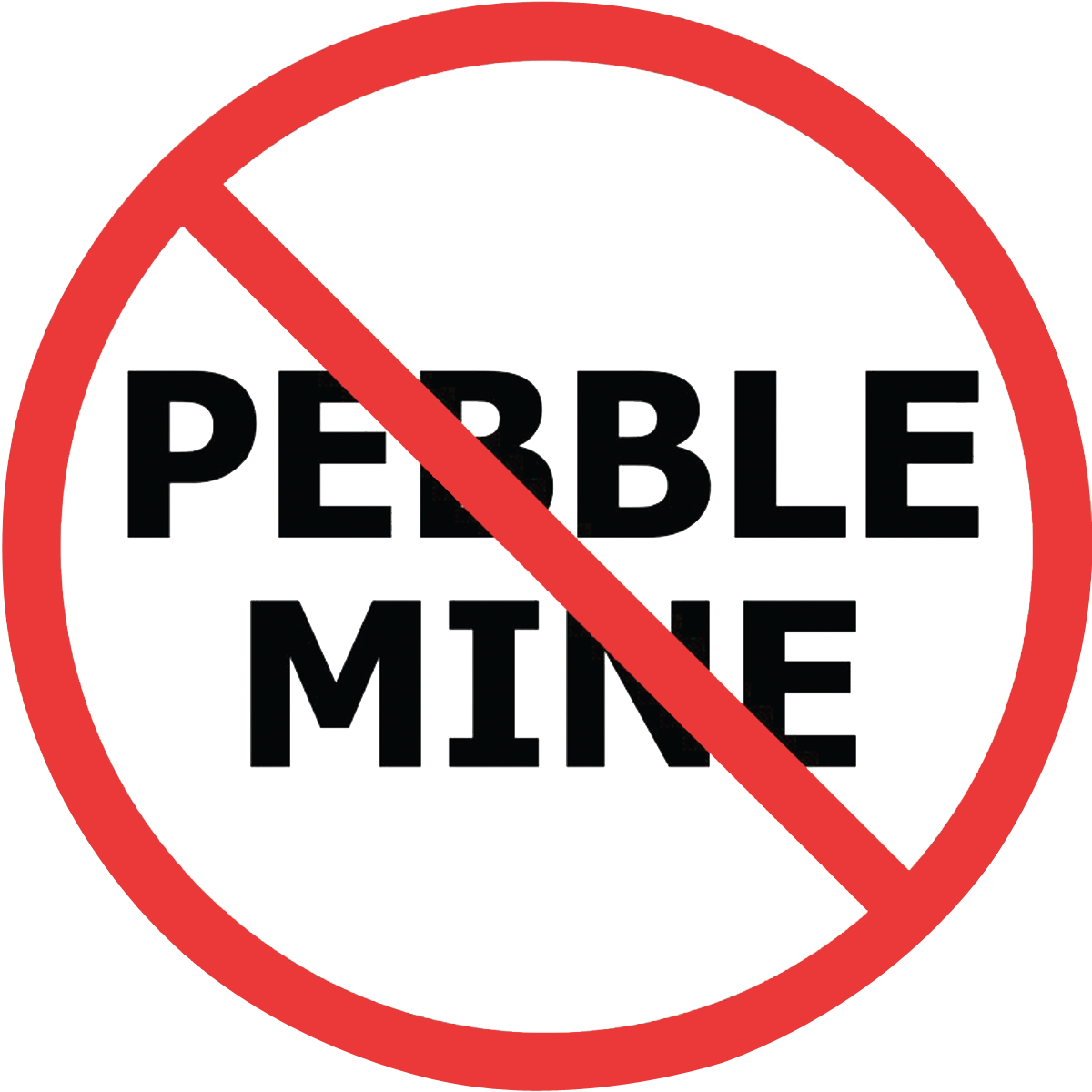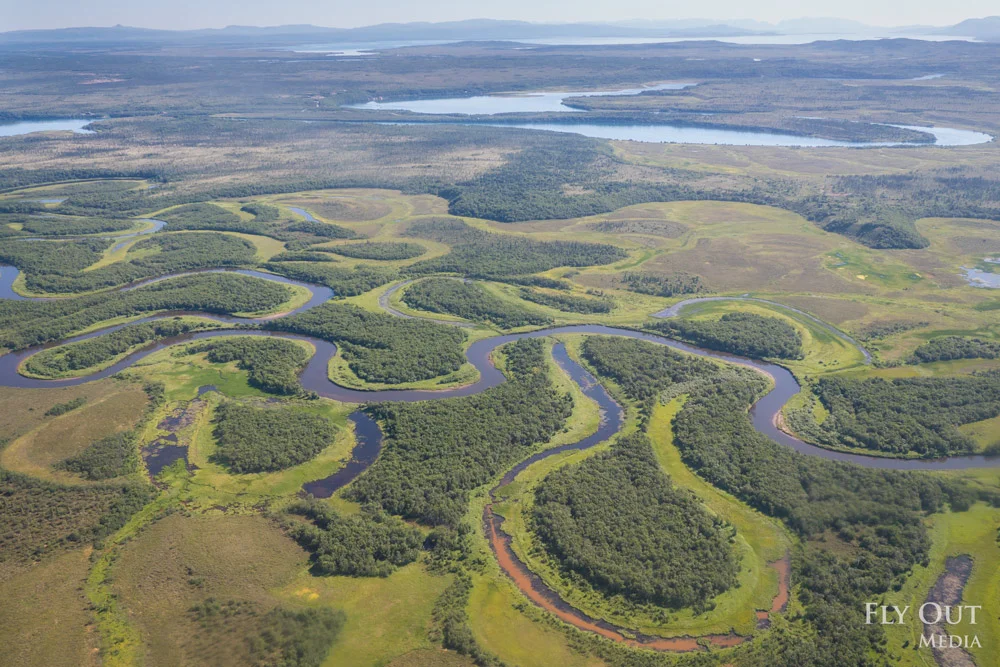Noting the continued lack of public approval, Mark Hamilton, Pebble’s external affairs employee, is on a tour to promote the mine throughout the state of Alaska. In the process, Hamilton has declared quite a few falsehoods pertaining to the potential for damage in Bristol Bay.
We asked two technical experts to reply to some of his most egregious statements. Below are the comments from Dave Chambers* and Sarah O’Neal.** Hamilton’s statements are in bold.
The Pebble “study area” is 1% of Bristol Bay. Pebble Mine will be 3% of that 1%.
SO: This figure is limited to the mine footprint, and excludes infrastructure, which will multiply impacts many-fold. The real point though is, Pebble would be just the beginning of a major industrial district which would ultimately impact salmon and habitat upstream of any development, as well as a lot of receiving waters.
Water [and thus contamination] cannot flow from Pebble Mine into Lake Iliamna or Upper Talarik Creek. The only place you can get water from the mine is the North Fork of the Koktuli River.
DC: There is a hydrologic path between the mine and Talarik Creek via the aquifer documented by Pebble itself that connects the North Fork with Talarik Creek, underneath the hills that separate the drainages, downstream of the mine. However, upon mine expansion, part of the mine will actually be in the Talarik Creek drainage.
SO: Right. There is no way to contain contamination to only the Nushagak drainage because of groundwater exchange.
Pebble Mine is not at the headwaters of Bristol Bay. It’s 168 river miles from the only river it could possibly touch under any circumstances.
DC: It’s more correct to say that the mine will be located in three “headwater streams” of Bristol Bay (North and South Forks of the Koktuli, and Upper Talarik). There is no single “headwaters” for Bristol Bay.
SO: This article does a good job of refuting this point. Here’s the crux of it:
“The argument that this giant mineral deposit is not in the headwaters of the Nushagak and the Kvichak Rivers relies on a dim notion that the headwaters is only the single stream in a watershed that is farthest from the ocean. Any thinking person knows that surface and ground waters flow downhill anywhere in a watershed, not just from the stream that's farthest from the ocean. As someone who has taught river ecology for 40 years, I know that the headwaters are where small streams first start to flow throughout a watershed. […] Any pollution from Pebble wouldn't just affect salmon near the mine site; it would travel easily downstream, through surface and groundwater. In fact, the porous nature of the Bristol Bay watershed that makes it such a great producer of salmon also makes it especially vulnerable to the kind of pollution that is caused by copper sulfide mining.” - Jack Stanford, Ph.D., is the Jessie M. Bierman Professor of Ecology at the Flathead Lake Biological Station of The University of Montana
On the Bristol Bay Watershed Assessment:
All the disasters that you’ve heard about come from the EPA and their design of the Pebble Mine.
DC: All of the “disasters” discussed by EPA have roots in failures and problems at real mines. The mine designs that EPA used are very close to the designs Pebble is now proposing for the “small” mine, and for the 6.5 billion ton mine build out scenario that the Army Corps, the agency currently reviewing Pebble’s phase 1 permit, has requested.
“They never went to the field. They never did science in the way that we think of science being done. They did a document search on the computers.” Let me tell you how bad it looks... “I’ve studied this thing for 10 months.”
DC: The EPA looked at the actual track record of similar mines, which requires record research. Pebble would like us to believe that because all of these problems have been identified at other mines, they will not occur at Pebble. Pebble’s representatives put their personal guarantee behind these statements, but this is not what history tells us actually happens. A good example of this is the failure of the Mount Polley tailings dam in British Columbia. The dam failed due to a well-understood failure mechanism, despite being designed, built, and operated by reputable mining companies, and in a regulatory environment (British Columbia) that has been described as the toughest in the world, something also claimed of the state of Alaska mine regulatory program.
SO: Another op-ed unfortunately still applies, and I think directly addresses how extensive the EPA’s scientific review process actually was. Here’s an excerpt: “Standard scientific peer review typically involves three anonymous reviewers. In contrast, a panel of 12 known experts -- ranging in expertise from mining to Alaska Native cultures, hydrology, and fisheries -- publicly reviewed EPA's draft assessment. Their task was to critique the assessment based on its scientific content and merit. Unlike standard peer review, input was accepted from more than 100 members of the public.”
“We should talk about toxicity. There is none. Mine doesn’t even use cyanide. What happens if it does go into the north fork of the Koktuli we can tell you precisely what it does, and it’s trivial.”
DC: This statement is beyond the pale. He must have misspoke. Most toxicity at mines is due to acid mine drainage, not cyanide, and the rock that will be exposed at Pebble has significant potential to generate acid mine drainage. Pebble’s plan is to collect nearly 100% of water impacted by acid drainage, and to treat this water in perpetuity. Most water quality issues at mines appear after mine closure, and collecting acid drainage has proven to be both difficult and expensive. The public ultimately bears the risks that the collection of acid mine drainage will not go as planned, or that the funds set aside for perpetual water treatment will run out.
SO: Acid mine drainage comes with TOXIC metals including copper, which is one of the most toxic elements to aquatic life. It can impair a fish's ability to smell at increases of just 2-20 parts per billion (equivalent to 2-20 drops in an Olympic-sized swimming pool). Fish use their sense of smell to identify mates and kin, predators, and prey, and to navigate their way back to their spawning grounds within meters of their birthplace. It is that ability to hone to their natal habitat which maintains the genetic diversity essential to overall population sustainability and persistence.
Regarding how many salmon are in the North Fork Koktuli: “1,500. We’ve counted them for a decade.”
DC: Assuming this number is correct – remember that Pebble once claimed there were no salmon on the mine site, a claim that has been proven to be false. If this is 1,500 spawning salmon, the number of salmon impacted can be multiplied by the number of eggs these salmon will lay. That becomes a lot of salmon. And, if the South Fork is impacted, Talarik Creek will also be affected because of the hydrologic connection between the two drainages.
SO: No one really knows how many fish use the streams draining the deposit, and those numbers are constantly fluctuating over space and time. While Pebble did make attempts to estimate escapement for five (not ten) years, their methodology was questionable at best (see this report by Dr. Carol Ann Woody). Mr. Hamilton also discounts the fact that the Koktuli River and its receiving waters support what is likely the world’s largest current wild king salmon run. Maintenance of king salmon habitat is crucial in this time of global declines, which is occurring even in rivers relatively untouched by development. Meanwhile, Pebble’s own data indicates that they counted 50,000 sockeye on ONE DAY, JUST in Upper Talarik.
The one in ten thousand year phenomenon that would cause pebble mine to leak into the North Fork Koktuli would kill 1,500 salmon.
DC: A one-in-ten thousand phenomenon, like a catastrophic earthquake or super-storm, could release mine waste that would damage a stream for hundreds of years. These events would continue to repeat themselves, even though it is on a scale of thousands of years, continuing to interrupt the health of the ecosystem for salmon.
We have in front of us the most stringent permitting process on the planet the U.S. Army Corps of Engineers, an independent 3rd party, is conducting with dozens of cooperating agencies.
DC: I have also heard industry and regulators say that British Columbia, Nevada, Montana, Michigan, Minnesota, and others describe their regulatory system as the “best,” so the claim that Alaska is the “best” has a hollow ring to it.
The state would get taxes, royalties, payment to the permanent fund, payment to State, huge payment to the Lake and Penn Borough, for road rental, tariffs, etc. from Pebble Mine. It will quadruple the Borough budget.
DC: Justifying benefits only in terms of money has both cultural and economic flaws. The benefits from mining – jobs and money – are non-renewable. In this case, mining threatens the renewable economy of commercial salmon fishing and sport fishing/tourism in the region. Despite promises to the contrary, the record of copper porphyry mining says this risk is credible. The people that are promising that mining will not impact fish will not be here to see that the promise is enforced.
The financial reward to communities must also be greater than the new costs imposed on these communities by increased population due to mining. Any surplus must be invested to insure that these communities will reap long-term, sustainable gains from mining revenue – which will end when the resource is exhausted. Making mining work long-term for a community is challenging, because it not only requires foresight to make good investments, but mining typically only pays local communities for its documented impacts. Mining is seldom involved in profit-sharing with communities.
There are also cultural values at stake in Bristol Bay. Many of the present residents value salmon and the present non-industrial condition of the Bristol Bay region over a cultural shift to a cash economy. These people can only lose if salmon are impacted, or if the area is opened to industrial development. Preserving custom and culture should mean more than just protecting cattle ranching in the west.
*Dr. Chambers has 40 years of experience in mineral exploration and development – 15 years of technical and management experience in the mineral exploration industry, and for the past 25 years he has served as an advisor on the environmental effects of mining projects both nationally and internationally. He has Professional Engineering Degree in Physics from the Colorado School of Mines, a Master of Science Degree in Engineering from the University of California at Berkeley, and is a registered professional geophysicist in California (# GP 972). Dr. Chambers received his Ph.D. in Environmental Planning at Berkeley. His recent research focuses on tailings dam failures, and the intersection of science and technology with public policy and natural resource management.
** Sarah O’Neal owns and operates Agua Dulce Freshwater Consulting where she works to provide fisheries and aquatic sciences expertise to non-profits and tribal groups in Bristol Bay, Alaska. Sarah has over 20 years of experience working in lakes and rivers around the world, primarily within salmon and trout habitat. She has specialized in water quality, aquatic plants, salmon and trout ecology, as well as public outreach on these topics. Sarah received her Bachelor's degree in Ecology, Evolution and Conservation Biology from the University of Washington and her Master's Degree in Organismal Biology and Ecology from the University of Montana's Flathead Lake Biological Station. She is currently pursuing her PhD in Fisheries and Aquatic Sciences at the University of Washington.
All photos by Fly Out Media



